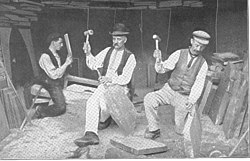Portal:Europe/Selected article/6
The slate industry in Wales began during the Roman period when slate was used to roof the fort at Segontium, now Caernarfon. The slate industry grew slowly until the early 18th century, then expanded rapidly until the late 19th century, at which time the most important slate producing areas were in northwest Wales, including the Penrhyn Quarry near Bethesda, the Dinorwic Quarry near Llanberis, the Nantlle Valley quarries, and Blaenau Ffestiniog, where the slate was mined rather than quarried. Penrhyn and Dinorwig were the two largest slate quarries in the world, and the Oakeley mine at Blaenau Ffestiniog was the largest slate mine in the world. Slate is mainly used for roofing, but is also produced as thicker slab for a variety of uses including flooring, worktops and headstones. Up to the end of the 18th century, slate was extracted on a small scale by groups of quarrymen who paid a royalty to the landlord, carted slate to the ports, and then shipped it to England, Ireland and sometimes France. Towards the close of the century, the landowners began to operate the quarries themselves, on a larger scale. After the government abolished slate duty in 1831, rapid expansion was propelled by the building of narrow gauge railways to transport the slates to the ports. The slate industry dominated the economy of north-west Wales during the second half of the 19th century, but was on a much smaller scale elsewhere.

